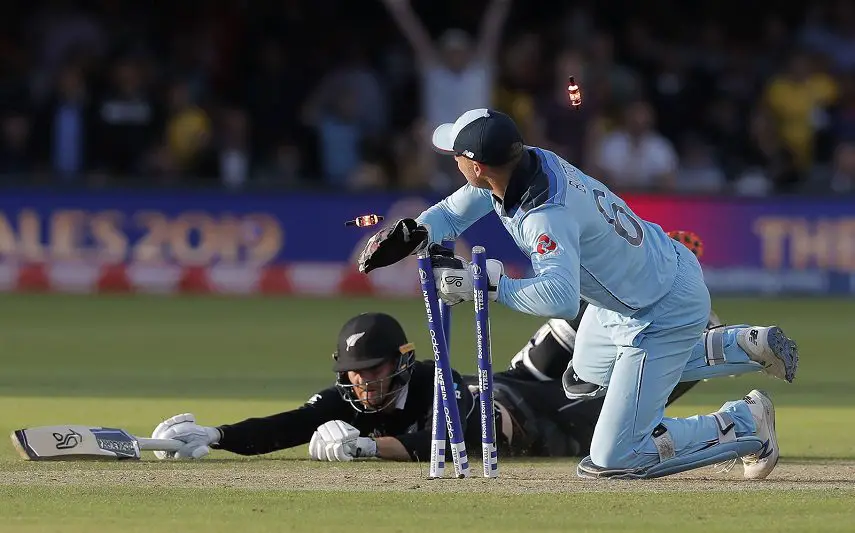Table of Contents
It’s a strategic option for a batting side and it can be used in a number of circumstances. In this article I’m going to look at the subject of innings declarations – what they mean and when they can be employed.
What is a Declaration in Cricket?
An innings can be declared at any time by the captain of the batting side. When they announce the declaration, the innings is over.
Declarations can form an important part of strategies in test and first class cricket. In the past, they have been used in limited overs cricket but laws have been changed to stop this happening.
Time of Declaration
The timing of the declaration is the most important thing to take into account. If time is running out in the game, the batting side may declare so that their bowlers have more time to dismiss their opponents.
Declarations can also be made in order to speed up a match. If, for example, rain has seen playing time reduced significantly, a batting team may declare their innings quicker than they would have normally done.
10 Controversial and Surprising Declarations in Cricket
The Adelaide Test of the 2006-07 Ashes Series
England travelled to Australia in 2006/07 looking to make a successful defence of the Ashes. Things didn’t go well in the first game as England lost heavily to go 1-0 down.
In the second game at Adelaide, England’s batters gave the team a chance to level things up. The tourists had reached 551/6 thanks to a brilliant double hundred by Paul Collingwood and a century from Kevin Pietersen.
At that point, skipper Andrew Flintoff decided to declare. It was a good total but there were four wickets left and it was a decision he came to regret. Australia made 513 in their second innings before England made just 129 second time around. The declaration had backfired and the Aussies went on to win by six wickets.
Hansie Cronje: South Africa versus England, 2000
I’ve already discussed the Hansie Cronje affair in greater detail in another article but no list of declarations would be complete without this one.
England toured South Africa in 1999/2000 and were second best in the test series. Nasser Hussain’s men were already 2-0 down as they came into the final game in Centurion. The series was gone and, thanks to incessant rain, it seemed as though things would end in subdued fashion.
Then came the declaration. Innings were forfeited and Cronje’s decision meant that England needed 249 runs to win on the final day. History tells us that the tourists scraped home in a tight and entertaining finish.
It had seemed like a magnanimous gesture on Cronje’s part to spice up a dying test. Later we would find out that there were more sinister reasons behind this declaration.
Somerset v Worcestershire, 1979
Have you ever heard about the One Day innings that was declared after just one over? Back in 1979, Somerset were playing Worcestershire in the league stages of the Benson and Hedges Cup.
Due to a complicated equation, Somerset captain Brian Rose worked out that his side would progress to the quarter finals if they protected their bowling strike rate. He duly declared the innings at 1/0 after one over. Worcestershire batted and won by ten wickets after 1.4 overs.
Rose’s actions were within the laws of the game at the time. They’ve since been changed to outlaw this type of action. The Somerset skipper received a ton of criticism, not least from the paying spectators who had been robbed of a day’s cricket.
England v West Indies, 1984
England skipper David Gower has been widely ridiculed for this declaration. Sensing the chance of victory, he declared his team’s innings on 300/9, leaving West Indies 342 to win in 78 overs.
Gower only had Bob Willis to come – one of the weaker batsmen of his generation – so we should have some sympathy. Nevertheless, he was made to look foolish when a double century from Gordon Greenidge helped the Windies to chase down that target for the loss of just one wicket.
West Indies v England: Trinidad, 1968
This game gave us what must be a very rare case of a team losing after declaring twice. Garry Sobers was in charge of the West Indies team and he called their first innings to a halt on 526/7. It was a substantial total and his decision looked to be vindicated after England were bowled out for 404.
Sobers’ second declaration is the more controversial. With his team at 92/2, he called the batsmen in to set the tourists a target of 215 on the final day. England met that target with seven wickets to spare.
The declarations did not go down well with the home crowd, especially as England won the series 5-0 on the back of this result.
Pakistan v India: Multan, 2004
There have been a number of controversial cases where captains have declared an innings as one of their batters is approaching a personal milestone. At Multan in 2004, a very brave Rahul Dravid called a halt to India’s first innings with Sachin Tendulkar undefeated on 194.
India batted first and that score of 194 had contributed to a total of 675/5 when Dravid called the batters in. It was a big total but it was a surprise to everyone that the skipper hadn’t allowed Tendulkar to reach a double century.
Dravid’s decision was a winning one: Pakistan made 407 first up. Following on, the home side made 216 to lose by an innings and 52 runs. Tendulkar was very diplomatic after the match but his legions of fans still talk about the controversial declaration to this day.
Australia v Pakistan: Adelaide, 2019
This was another case of a declaration potentially robbing a batter of a personal milestone. In this instance, Australia’s David Warner was homing in on the biggest landmark of them all when he had reached 335 in the Adelaide test against Pakistan in 2019.
Australia had reached 589/3 at this point and there was plenty of time left in the game. However, the Aussie skipper Tim Paine was worried about the potential for rain taking some of that time out of the match.
Paine declared with many feeling that Warner could have gone on to beat Brian Lara’s test record of 400. The rain didn’t arrive and Pakistan were bowled out for 302 and 238 as Australia won by an innings.
West Indies v India: Jamaica, 1976
We’ve just seen a case of a successful Indian declaration but Bishen Bedi’s decision in the 1976 test at Sabina Park would not work in his favour. At 306/6 in the first innings, the skipper called his batsmen in.
It was a relatively low total but there’s more to this story. This was a game where Clive Lloyd unleashed his pace bowling battery on some unfortunate Indian players. Two players retired hurt in the innings and were not able to return to the wicket.
Bishen Bedi claims that the innings was completed but it’s listed in the scorecard as an official declaration. West Indies went on to win the game comfortably but their overuse of the short ball left a bitter taste.
Australia v England: Melbourne, 1937
This test match featured two declarations but it was the second one, carried out by England skipper Gubby Allen, which will go down as a bad call. Australia batted first and declared their innings closed on 200/9.
England crumbled in response to 76/9 before Allen made his decision. It’s said that he was looking to expose the Aussie batsmen to poor conditions at the end of the day but the home side responded by sending in no fewer than four nightwatchmen.
Playing conditions improved and Australia made 564 as Don Bradman scored 270. England were left with a mammoth 689 to win and they fell short by 365 runs.
In truth, England’s final wicket pairing wouldn’t have made too much difference to the result. However, any declaration looks embarrassing when a team loses by such a wide margin.
Middlesex v Somerset: Lord’s, 2007
A declaration at 50/8 is always going to be talked about. Somerset skipper Justin Langer called his team in after they had stuttered to this score in a County Championship game against Middlesex at Lord’s.
Middlesex won the game easily and the result never looked to be in doubt so why did Langer do it? There is a theory that his actions were merely carried out in spite, in order to rob Middlesex of a final bowling bonus point.
Whatever the reasons, that first innings declaration was part of a very ill-tempered game which the home side eventually won with seven wickets to spare, chasing 138.
Conclusion
The innings declaration is a fascinating area of the game. It’s all about implementing a strategy and to give the batting side a better chance of winning.
I’ve skippered at club level and, if you have too, you may already know about the importance of timing a declaration. In one innings games where there is no restriction on the amount of overs to be bowled, it’s a fine balance. Do you have enough runs and have you left your team enough time to bowl the opposition out?
These are the same questions that will run through the heads of captains at a professional level. It’s interesting to follow the thinking behind this part of the game and hopefully we’ll all have a better understanding of declarations after reading this article.


